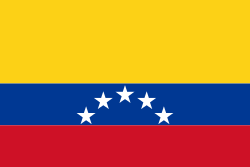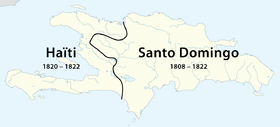Republic of Spanish Haiti
The Republic of Spanish Haiti (Spanish: República del Haití Español), also called Independent State of Spanish Haiti (Spanish: Estado Independiente del Haití Español)[2][3] was the independent state that resulted from the defeat of Spanish colonialists from Santo Domingo on November 9, 1821, led by General José Núñez de Cáceres.[4][5]
Republic of Spanish Haiti República del Haití Español | |||||||||
|---|---|---|---|---|---|---|---|---|---|
| 1821–1822 | |||||||||
 Flag | |||||||||
 The Republic of Spanish Haiti in the east of Hispaniola | |||||||||
| Capital | Santo Domingo | ||||||||
| Common languages | Spanish | ||||||||
| Demonym(s) | Dominican[lower-alpha 1] | ||||||||
| Government | Republic | ||||||||
| President | |||||||||
• 1821–1822 | José Núñez de Cáceres | ||||||||
| Historical era | 19th century | ||||||||
• Independence | December 1, 1821 | ||||||||
• Haitian occupation | February 9, 1822 | ||||||||
| Area | |||||||||
| 48,442 km2 (18,704 sq mi) | |||||||||
| Currency | Santo Domingo real | ||||||||
| |||||||||
| Today part of | |||||||||
History
Preparations for independence (1820–1821)
Haitian President Boyer decided to prepare for a rumored military advancement by Spain in the Haitian republic due to repetitive rumors that the French and the Spanish were going to invade the vulnerable east side of the island.
In 1820, Boyer sent Colonel Dezir Dalmassi to nearby towns such as Las Matas, San Juan de la Maguana and Azua to convince locals to join a Republic that would provide them with jobs and great benefits.[6] Instead of waiting for Dalmassi's return to Haiti, Boyer decided to invade the eastern part of the Island before Jose Nuñez de Caceres could finalize his intent to join Gran Colombia.[7]
Haiti had been offering protection under the Haitian government in form of jobs, lands, abolition of taxes in the exportation of livestock, in return of accepting the political unification of the two territories.[6]
On December 1, 1821, a constitutive act was ordered to petition the union of Spanish Haiti with Gran Colombia. The state of the Republic of Spanish Haiti was not supported by the population of slaves and servants who were wary of the rule of pure whites, and preferred to unite with French Haiti, because of their abolition of slavery.[8]
In late 1821 and early 1822, Haiti sent emissaries to the central and northern Spanish Haiti to promote the accession of the country to Haiti, and the people began to raise the Haitian flag on public buildings and plazas, among them Hincha (present-day Hinche), but also in another large cities like Puerto Plata (13 December 1821), Dajabón (15 December), Santiago (29 December) and La Vega (4 January 1822),[9][10][11] whereas other forces which opposed unification with Haiti formally declared independence from Spain on December 1, 1821.[12]
Independence (1821–1822)
On December 30, 1821 at 11:30 p.m. the tropas de morenos (Spanish for '"Coloured Corps"'), led by Pablo Ali and José Núñez de Cáceres, surprised the Fortaleza Ozama's guards and jailed Governor Pascual Real in the Torre de Homenaje (the keep) of Santo Domingo.[6] The next morning, at 6:00 a.m., the cannon fire signalled the political change taking place.
A group of politicians and military officers continued to favor uniting the new nation with Haiti, as various elite families sought for political stability under Haitian president Jean-Pierre Boyer. A large faction based in the northern Cibao region were opposed to the union with Gran Colombia and also sided with Haitian president Boyer. Boyer, on the other hand, sought to protect his country from the possibility of France's or Spain's retaking Spanish Haiti and attacking or even re-conquering Haiti. He sought not only to maintain Haitian independence, but to maintain the freedom of its former slaves, as well as to liberate the remaining slaves in Spanish Haiti. After promising his protection to the government of Núñez de Cáceres, Boyer entered with a force of 12,000 soldiers in February 1822, after most cities and towns proclaimed its annexation to the Republic of Haiti between November 1821 and January 1822, including Puerto Plata (December 13, 1821) and Santiago (December 29, 1821).[12][9][13][14]
On February 9, 1822, Boyer formally entered the capital city, Santo Domingo, where he was met with enthusiasm and received by Núñez de Cáceres who offered to him the keys of the Palace. Boyer rejected the offer saying: "I have not come into this city as a conqueror but by the will of its inhabitants".[9] The island was thus united from "Cape Tiburon to Cape Samana in possession of one government."[12]
Political reforms
The first public act of Boyer was to enact the abolition of slavery and promise lands to all freed men so they could freely dedicate their lives to agriculture in acres donated by the State.
In Haiti, the French system of private land ownership guaranteed by the State was the norm, while the Spanish section the predominant system was communal grounds and a hierarchy of tenancy that clashed. By June 15, Boyer was still promising nationally donated land. In order to donate this land, the Haitian administration prohibited ownership of land by white Dominicans, depriving the main popular families of the country of their lands.[15]
The portion of freed slaves who did not wish to keep working with their former masters had little option but to join the military, which formed the Batallon 22, which joined the 'morenos libres' (Free mulattos) under Colonel Pablo Ali constituted the principal military force to the East of the island.[6]
Other cultural changes were the restriction of the Spanish language and traditional customs like cock fights were eliminated.[15]
Boyer enacted a Rural Code which was “designed to force yeomen into large-scale production of export crops. The nation, however, lacked the wherewithal, the enthusiasm, and the discipline to enforce the code”.[7]
Haitian rule in the island lasted 22 years. It wasn't until 1844 that independence was possible due to a young Dominican man, Juan Pablo Duarte y Díez.
Eventually the Haitian government became very unpopular, due to the severe economic crisis that hit the country after paying a huge indemnity to France, and gave rise to many anti-Haitian plots. It lasted until 1844, when the independent nation of the Dominican Republic was established.[4][12][9][13]
References
- Notes
- According to the Declaratoria de Independencia del Pueblo Dominicano. (Independencia; Efimera 1821); the term Dominican was used.[1]
- Citations
- "Declaratoria de la independencia del 1821". Retrieved April 14, 2018.
- "José Nuñez de Cáceres". Educando.edu.do (in Spanish). March 23, 2007. Archived from the original on May 13, 2014. Retrieved October 6, 2011.
- "De la Ocupación Haitiana a la Independencia". Mundo Dominicano (in Spanish). March 23, 2007. Archived from the original on October 10, 2011. Retrieved October 6, 2011.
- Lancer, Jalisco. "The Conflict Between Haiti and the Dominican Republic". All Empires Online History Community. Retrieved April 14, 2018.
- "Haiti - Historical Flags". Flags of the World. Archived from the original on May 5, 2005. Retrieved December 24, 2007.
- Ponz, M. F (2000). Manual de Historia Dominicana. Santo Domingo: Caribbean. p. 225.
- Haggerty, R. S. (1989). "Country Studies: Federal Research Division". Federal Research Division. VI: 218.
- Franco Pichardo, Franklin J. (2009). "Capítulo XIII: Nueva Guerra de España con Inglaterra". Historia del Pueblo Dominicano (in Spanish) (8th ed.). Santo Domingo: Ediciones Taller. p. 115.
- Franco Pichardo, Franklin J. (2009). "Capítulo XVII: El Período de la España Boba / Capítulo XVIII: Período de Integración con Haití". Historia del Pueblo Dominicano (in Spanish) (8th ed.). Santo Domingo: Ediciones Taller. pp. 176–216.
- Amín Arias (July 25, 2012). "Algo más sobre la "invasión haitiana de 1822"". Blog: Al Otro Lado del Charco (in Spanish). Retrieved October 3, 2012.
(...) desde primeros de noviembre de 1821, semanas antes de la proclama de Núñez de Cáceres, muchos cabildos hispanos de la zona fronteriza habían proclamado su pertenencia a la República de Haití. Esas proclamas se sucedieron por todo el Norte y el Sur dominicano, hasta, por ponerle como ejemplo, que Pablo Báez, Alcalde de Azua, hombre blanco, terrateniente, amancebado con una negra liberta, padre de Buenaventura Báez, quien fuera presidente de la República Dominicana durante cinco períodos... se unió a Haití, luego de las proclamas de San Juan de La Maguana, Bánica, Hincha, San Rafael, San Miguel, Neyba, Puerto Plata, etc., etc.
Todo esto sucedió en los cabildos y en las plazas de la parte Este de la isla sin que Boyer hubiera movido un dedo. Los dominicanos del este (porque es el gentilicio de todos los nacidos en la isla de Santo Domingo, como comunmente se conoce a nuestra isla) no querían una República independiente como la de Núñez de Cáceres que no abolía la esclavitud y que continuaba con la estratificación establecida por los colonizadores respecto a las clases y las razas. Es decir, los mulatos dominicanos (que eran la mayoría) querían ver reconocidos sus derechos al igual que los blancos. Los negros querían dejar de ser esclavos. Y eso la nueva república de Núñez de Cáceres no lo garantizaba.
Sin embargo, ser parte de Haití les permitía a todos ese derecho. Cuando Boyer llegó a Santo Domingo ya todas las ciudades de la línea del Sur se habían proclamado haitianas. Él no fue quien las proclamó. Ellas mismas atendieron al llamado del Presidente de una de las Repúblicas más pujantes de la época, como era la haitiana, la primera república latinoamericana y la segunda, después de los Estados Unidos, en todo el continente americano. Boyer recibió las llaves de la ciudad porque los miembros de la élite comercial dominicana, representanda por Núñez de Cáceres, no encontraron apoyo ni siquiera en Simón Bolívar, libertador de América, quien sí apoyaba a la República de Haití porque era un país que abolió desde el primer momento la esclavitud. - Rodríguez, Pablo (2002). Puerto plata: Perfil histórico y económico (in Spanish). Ediciones Renovación. p. 42. ISBN 978-9-993-42278-5. Retrieved May 21, 2014.
En diciembre de 1821, Puerto Plata, Santiago y algunos habitantes de Cotuí se manifestaron a favor del partido pro-haitiano. A esta proclamación a favor de un estado pro-haitiano con un gobierno en la isla, se unieron en 1822 La Vega, San Francisco de Macorís, Azua, San Juan de la Maguana y Neiba.
- Gates, Henry Louis; Appiah, Anthony (1999). "Dominican-Haitian Relations". Africana: The Encyclopedia of the African and African American Experience. Retrieved December 24, 2007.
- Matibag, Eugenio (2003). Haitian-Dominican Counterpoint: Nation, State, and Race on Hispaniola. Retrieved December 24, 2007.
- Corbett, Bob. "1818-1843 The rule of Jean-Pierre Boyer". The History of Haiti. Retrieved December 24, 2007.
- Manuel Moreno Fraginals; Frank Moya Pons; Stanley L. Engerman, eds. (1985). Between Slavery and Free Labor: The Spanish-Speaking Caribbean in the Nineteenth Century. Baltimore and London: Johns Hopkins University Press. ISBN 978-0-801-83224-6.
